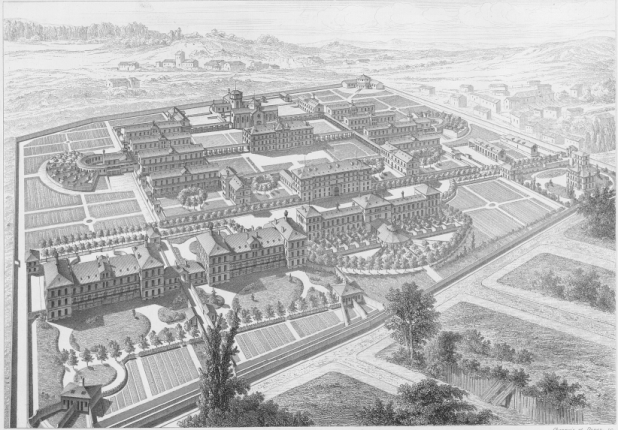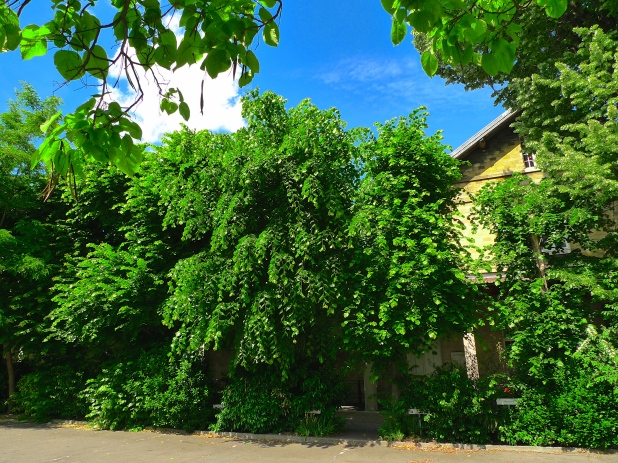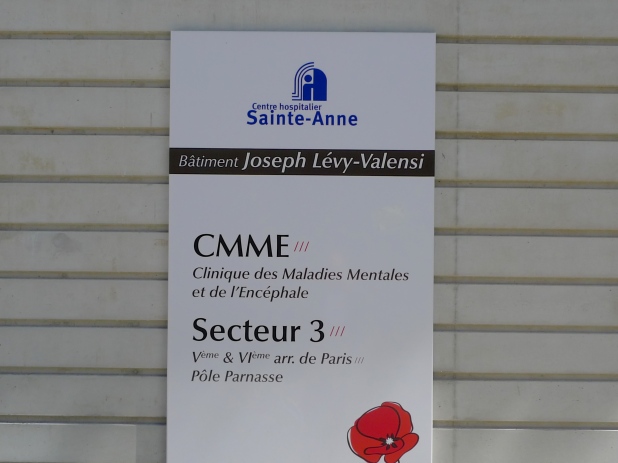Centre Hospitalier Sainte-Anne
FOUNDED BY NAPOLEON III in 1863 as an asylum, the Centre Hospitalier Sainte-Anne in rue Cabanis in the 14th arrondissement is now not only an official monument historique, it’s also a hospital specialising in psychiatry and neuroscience.
The origins of the hospital date back much further though.
On 7th July 1651, the governors of the Hôtel-Dieu and representatives of the Queen regent, Anne of Austria, signed a contract in which the Hôtel Dieu gave up buildings and land of the Maison de la Santé in Faubourg St Marcel in exchange for which the Queen regent gave twenty-one acres of land to establish a hospital. A condition was that the new hospital should take the name of the patron saint of the Queen regent, mother of Louis XIV: Saint Anne.
The hospital began as a farm, la ferme Sainte-Anne, which employed inmates from the nearby Asylum de Bicêtre, a notorious prison and lunatic asylum, but where in 1793, Superintendent Philippe Pinel is credited as being the first to introduce humane methods into the treatment of the mentally ill.
In 1863, Napoleon III decided to create a psychiatric hospital in Paris on the site of la ferme Sainte-Anne. The Centre Hospitalier Sainte-Anne was to be a clinical asylum marking a shift of emphasis from just the containment of the mentally ill towards research into and the treatment of mental illness.
The French architect Charles-Auguste Questel took charge of the project and work proceeded over a period of four years. The hospital was inaugurated on 1st January 1867 and the first patient was admitted on 1st May of the same year. Most of the original buildings still exist and are still in use.
The asylum in 1877: Revue générale de l’Architecture et des Travaux Publics, 1877, n°4 (volume 34ème)
Le pavillon Magnan de l’hôpital Sainte-Anne
In the years that followed, the Centre Hospitalier Sainte-Anne expanded its role beyond just the psychiatric treatment of its patients. Departments for general surgery and dental surgery were created to provide treatment for patients from all the asylums in the Département de la Seine along with an obstetric department and laboratories for radiology, microphotography and biology.
A major breakthrough occurred in 1920 when the French psychiatrist, Edouard Toulouse, set up the Comité d’hygiène mentale, a mental health committee designed to seek the most effective medical and social means for treating mental illness. In 1922 this resulted in the Centre for mental disease prevention, which aimed to improve the treatment of patients by developing outpatient as well as inpatient centres.
Another breakthrough came in 1952 when the French psychiatrist, neurologist, writer and member of the Académie française, Jean Delay, along with J. M. Harl and Pierre Deniker discovered that a high dose of chlorpromazine produced a considerable reduction in the agitation and aggression of those patients with symptoms of schizophrenia. Chlorpromazine was released onto the market in 1953 by Rhône-Poulenc and given the trade name Largactil and it’s still in use today.
Today, the Centre Hospitalier Sainte-Anne has seven adult psychiatric units, two child and adolescent psychiatric units as well as an addiction unit. It also has centres for neurology, neurosurgery, neuroradiology, neurophysiology, neuropathology, anaesthetics, dentistry, physical medicine and rehabilitation.
The hospital is also a teaching hospital for students of the faculty of medicine at the Université Paris Descartes.
I went to explore the Centre Hospitalier Sainte-Anne and discovered that the site covers thirteen hectares (32 acres), including seven hectares (17 acres) of protected green space. Some of this green space is reserved for patients but most of it is accessible to the public.
On one side of a staff car park close to the central pharmacy I discovered some sounds of summer.
Sounds of the Centre Hospitalier Sainte-Anne:
One of the modern additions to the hospital is the new home of the Clinique des Maladies Mentales et de l’Encéphale (CMME), a sixty bed psychiatric unit supervised by four university professors.
The unit specialises in four main areas; eating disorders, mood disorders (including recurrent depression resistant to treatment, seasonal affective disorder, attention deficit hyperactivity disorder and anxiety disorders), suicidal patients and addiction.
Clinique des Maladies Mentales et de l’Encéphale (CMME)
The CMME is one of several new developments at the hospital so as I walked past it I was not surprised to discover the sound of construction work pervading the air. I stopped to capture the sounds of nature and construction work competing with each other.
Centre Hospitalier Sainte-Anne – Outside CMME:
Walking around the grounds of the hospital looking at some of the original buildings I couldn’t help but imagine what this place must have been like when the treatment of mental illness was in its infancy, even though France was quite enlightened in its approach by the standards of the time.
In 1838 France enacted a law to regulate both the admissions into asylums and asylum services across the country allowing mentally ill patients to gain access to treatment for their disorders in specific and appropriate institutions. This law remained in force until as late as June 1990 when it was revised.
Outside the Centre Hospitalier Sainte-Anne in rue Cabanis stands the controversial Le plancher de Jeannot / Jeannot´s floor, a chilling reminder of the effect that mental illness can sometimes have.
Inside the three panels are sections of a fifteen square metre wooden floor engraved with a message of eighty lines by a young man named Jeannot.
Jeannot was born in 1939 in a small community in the Béarn department in the south of France where his parents owned a farmhouse and some forty hectares of land.
In 1959, Jeannot’s father committed suicide. Jeannot, one of his sisters and his mother continued to live in the house but the family gradually became more and more isolated. Jeannot began to exhibit paranoid behaviour and he was admitted to a psychiatric hospital but he reacted so violently that he was unable to be treated. When his mother died in 1971, Jeannot buried her in the house, under the staircase.
Over the next few months, using a hand drill to make small holes, which he then connected with lines cut out with a knife and a gouge, Jeannot composed a text on the wooden floor of the living room. In brief, the text says that religion is the cause of evil in society,
Soon after completing the text Jeannot died, probably starving himself to death. Together with his mother he was buried in the local cemetery. His sister continued living in the house, alone. She was found dead in 1993.
The house was sold but the brocanteur who dealt with the house clearance noticed the inscriptions on the floor. Finding this unusual, he made contact with a psychiatrist, Dr Guy Roux. Dr Roux bought the floor from the new owner of the house. He later sold it to the pharmaceutical company Bristol Meyer Squib.
Le plancher de Jeannot was exhibited for the first time in the year 2000 at an international psychiatric congress in Paris as part of an exposition entitled 50 ans d´expression en milieu psychiatrique. It was later exhibited in the Bibliothèque Nationale in Paris where it gave rise to a heated public debate around the question: is it acceptable to present as a work of art the expression of someone in such psychological distress?
In 2007, Jean Pierre Olié, professor of psychiatry and chief psychiatrist of the Centre Hospitalier Sainte-Anne became involved and it was arranged that the floor, cut into three parts, should be put on display outside the hospital in the rue Cabanis.
The complete text of Le plancher de Jeannot: Click to enlarge
“A sick thought can devour the body’s flesh more than fever or consumption.”
Guy de Maupassant : Le Horla et autres contes fantastiques
The days of ‘lunatics’ and ‘asylums’ may be gone but the shame and stigma surrounding mental illness still persists. It may be less now than in the past but it’s still there.
Institutions like the Centre Hospitalier Sainte-Anne have contributed significantly to the diagnosis and treatment of mental illness but it’s up to of the rest of us to come to terms with the fact that mental illness is exactly what it says, an illness – an illness that one in five of us will suffer from at some point in our lives.
“Mental illness is nothing to be ashamed of, but stigma and bias shames us all”.
Bill Clinton
























What a beautiful portrait of this hospital. The sounds of the birds could be so tranquil yet maybe they also acted to remind the patients of the isolation they were experiencing. Great recordings and photos.
Thanks, JD. Good to hear from you.
Yes, the sounds of the birds were very tranquil and those sounds are to be found all over the hospital grounds. The seemingly constant sounds of the building work however, even though it signals better facilities for the future, I found to be quite tortuous.